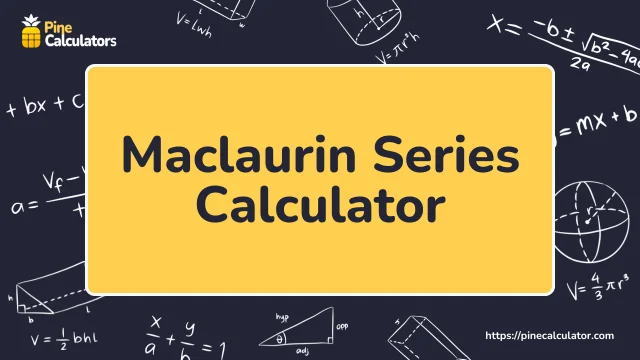Introduction to Maclaurin Series Calculator:
Maclaurin series Calculator is an amazing digital tool that is used to find the Maclaurin series expansion of a given function at a point a=0. It is used to evaluate the approximation value of a given function into an infinite sum of series.

Our tool is beneficial for students, teachers, or researchers who want to get a solution for the Maclaurin series in a few seconds without doing any manual calculations in just one click.
What is the Maclaurin Series?
The Maclaurin series is defined as the infinite series that is generated when you use the differential of a given function at its center where a=0. It is a type of Taylor series at the center point.This type of series is mostly used for functions like sin x,cosx, and ex that give the approximate value of a given function.
Although it does not give as much accuracy in solution as the Taylor series gives it gives a nearly estimated value of x at the origin of a function.
Formula of Maclaurin Series:
For the function f(x) the formula of the Maclaurin series used by the maclaurin polynomial calculator at its origin is given as:
- f(x) is the given function of x variable
- f^n(0) is the nth derivative of a given function f(x) at x=0
- n! is the n factorial value as n=0,1,2,3,...
How to Calculate the Maclaurin Series?
For calculating the Maclaurin series of a function the maclaurin calculator follows different steps. Let's see the calculation of the Maclaurin series calculator with steps:
Step 1:
Identify the function f(x) around the origin point a=0
Step 2:
Differentiate the given function with respect to x n times
For f(x)=fn(x)
- f′(x)=d/dxf(x)
- f′′(x)=d2/dx2f(x)
- f′′′(x)=d3/dx3f'(x)
- and so on...
So, f`(n)(x) = f(n)(x) n≥0.
Step 3:
Now, evaluate these derivative functions at x=0
- f(x) = f(0)
- f′(x) = f'(0)
- f′′(x) = f''(0)
- f′′′(x) = f'''(0)
- and so on...
Step 4:
The Maclaurin series expansion of a function f(x) around a=0 is given by:
$$ f(x) \;=\; \sum_{n=0}^{\infty} \frac{f^n (0)}{n!} x^n $$
Step 5:
Put the above value into the Maclaurin series formula at x = 0 and simplify it if needed.
Solved Example of Maclaurin Series:
The solved example of the maclaurin series gives you an idea about the working method of the maclaurin polynomial calculator.
Example: Find formula for nth degree maclaurin polynomial.
$$ f(x) \;=\; e^x $$
Solution:
Determine the given function at x=0,
$$ f(x) \;=\; e^x $$
Find the derivative of f(x) with respect to x,
$$ f(x) \;=\; f’(x) \;=\; f’’(x) \;=\; … =\; f^n (x) $$
as f`(x)=ex so that means,
$$ f’(x) \;=\; f’’(x) \;=\; … =\; f^n (x) \;=\; e^x $$
Put x=0 at each function of differentiation,
$$ f(0) \;=\; f’(0) \;=\; f’’(0) \;=\; … =\; f^n(0) \;=\; 1 $$
Put all the above values in the maclaurin series formula,
$$ P_n(x) \;=\; f(a) + f’(a)(x - a) + \frac{f’’ (a)}{2!}(x - a)^2 + \frac{f’’’(a)}{3!}(x - a)^3 + … + \frac{f^n (a)}{n!} (x - a)^n $$
$$ f(0) \;=\; f’(0) \;=\; f’’(0) \;=\; … =\; f^n (0) \;=\; 1 $$
$$ p_0(x) \;=\; f(0) \;=\; 1 $$
$$ p_1(x) \;=\; f(0) + f’(0)x \;=\; 1 + x $$
$$ p_2(x) \;=\; f(0) + f’(0)x + \frac{f’’(0)}{2!}x^2 \;=\; 1 + x + \frac{1}{2}x^2 $$
$$ p_3(x) \;=\; f(0) + f’(0)x + \frac{f’’(0)}{2} x^2 + \frac{f’’’(0)}{3!}x^3 \;=\; 1 + x + \frac{1}{2}x^2 + \frac{1}{3!}x^3 $$
$$ p_n(x) \;=\; f(0) + f’(0)x + \frac{f’’(0)}{2}x^2 + \frac{f’’’(0)}{3!}x^3 + … + \frac{f^n(0)}{n!}x^n $$
$$ =\; 1 + x + \frac{x^2}{2!} + \frac{x^3}{3!} + … + \frac{x^n}{n!} $$
$$ =\; \sum_{k=0}^n \frac{x^k}{k!} $$
The solution of a given function f(x)=ex is,
$$ =\; \sum_{k=0}^{n} \frac{x^k}{k!} $$
The maclaurin series function graph is,
PASTE THE GRAPH HERE!
How to Use Maclaurin Series Calculator?
Maclaurin calculator has a user-friendly interface that provides you with a given function at its center point.
You just need to follow some instructions that are given below before using this maclaurin polynomial calculator. The uses are given below,
- Enter your given function in the respective field which maclaurin series expansion solution you want.
- Add the orders of derivation n in the relevant box.
- Choose the variable which you want to differentiate the given function for the maclaurin series.
- Click on the calculate button to get the result in the form of expansion of the maclaurin series.
- The recalculate button will bring you back to the home page for more calculation of maclaurin series examples.
Final Result of Maclaurin Expansion Calculator:
Maclaurin series expansion calculator will get the result of the given function instantly after adding the input value which may include as:
- Solution section:
It will provide you with the solution of given maclaurin series problem.
- Possible steps section:
It gives you the Maclaurin series expansion solution in the stepwise method.
- The Recalculate button provides a new page for further evaluation of the Maclaurin series.
Benefits of Maclaurin Calculator:
The maclaurin polynomial calculator will provide you with multiple benefits as it will give solutions of various types of the Maclaurin series function. These benefits are:
- The Mclaurin series calculator gives you an accurate solution of the Maclaurin problem without any man made error because it has up to date features.
- You can use this tool to solve different examples of maclaurin series problems so that you get a strong hold on this concept.
- Maclaurin series calculator saves time that you consume in doing manual calculation of the Maclaurin series function.
- It has a simple design that allows everyone to easily use it to solve the Maclaurin series problem.
- Find the maclaurin series is a manageable tool as it is used from any electronic device through the internet.
- Our maclaurin expansion calculator provides a speedy calculation of the Maclaurin function in fraction of second without any mistake.










